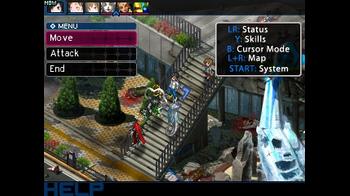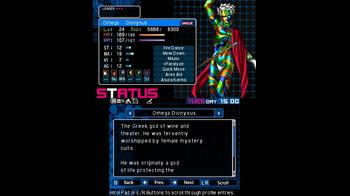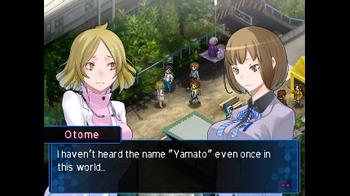Shin Megami Tensei: Devil Survivor 2 Record Breaker Review
Originally announced more than two years ago, Shin Megami Tensei: Devil Survivor 2 Record Breaker took its time to finally arrive on store shelves. This is an enhanced port for the second title in the Devil Survivor spinoff series, adding voices and a new scenario to the original Nintendo DS title which released back in 2012.
Devil Survivor is the strategy RPG subseries of the Shin Megami Tensei franchise, but it's a bit different than something like Final Fantasy Tactics or Fire Emblem. Instead of simply controlling individual units on a grid, the player forms several teams comprised of a human leader and two supporting demons.
You then maneuver these teams to engage enemy groups around the battlefield. When encountered, a classic SMT-style first-person battle will take place - your team versus theirs - and the goal is to use attacks and abilities to take their HP down to zero. Record Breaker plays identically to its predecessor in this regard.

This hybrid of strategic structure and turn-based battles allows for a significant level of player agency when it comes to how you can approach combat. Battle movesets, elemental affinities, supporting skills, and of course positioning are all factors to finding success in enemy engagements.
The player is given full control both over how they coordinate their parties and how they decide to tackle the various maps of the game. When challenges arise, it's up to the player to decide how they can tweak their set up and cover for any deficiencies their squad has.
As with most Shin Megami Tensei titles, demon fusion is a crucial element to the game. Demons are obtained via the Demon Auction, which is one of the more simple demon acquisition methods in the series. Rather than persuading demons to join or collecting tarot cards, you simply go to the a virtual store to purchase them.
While technically an 'auction' where you have to bid against artificial opponents, besting their bids is a trivial matter. You can then take these demons and fuse them together to create more powerful demons with specified movesets based on the details of the fusion.
Devil Survivor 2 introduces several conveniences to improve the experience. There are two difficulty modes to choose from, and on the easier mode you can keep your gathered EXP and retry right away if you fall in battle, whereas in Devil Survivor Overclocked you had to reload from the main menu. Skill Cracking, the method in which new abilities are obtained, is also slightly streamlined thanks to the FATE system, which allows multiple characters to obtain skills from the same enemy unit.
The pool of characters is also expanded and opened to the player more rapidly.
As each character has a unique stat distribution, you can swap in whichever you feel works best for your style of play. Backup characters also gain EXP so there's no penalty for using whichever characters you choose to.
Where Record Breaker differs from its predecessor is its style and tone. The basic premise of the game is familiar: Japan has seven days left until annihilation, and its up to an unlikely group to solve the mystery of the crisis and put an end to it.
However, the narrative plays out very similarly to popular anime series Neon Genesis Evangelion more than anything else. The main story beats of the game revolve around plans to defeat mysterious extraterrestrial invaders, whereas Overclocked was structured more like a continually unraveling mystery about the fate of the world.
While there are underpinnings of SMT-style themes and motifs, they are secondary to the main story here. In a nutshell, Record Breaker doesn't really feel much like an SMT game, narratively speaking. This is a little disappointing, but the plot moves with good pace to keep things fresh throughout.
The game is a bit more character focused than its predecessor as well, despite having more characters in general. Interlaced between story events are character events, where you can chat with your party to learn about them and their personalities. This raises affinity with them in the FATE system, which can unlock new demons and add elemental resistances in battle - think of it as a Social Link-lite like from the Persona series.
As aforementioned, characters are fully voiced this time around, and the English voice work is generally much improved compared to the efforts in Overclocked. Many of the performances compliment the character personalities and dialogue quite well, but a few still fall flat, however.
Unlike Overclocked, there is a 3D effect enabled this time around. However, most of the game is still played on the bottom screen, with the upper 3D capable panel used mostly for menu interfaces.
New to the Record Breaker re-release is the Triangulum scenario, which follows the narrative of the original game. This time Yamato, leader of the main team, is nowhere to be found, and instead the mysterious Miyako is in charge.
Not only that, but even more beings have come to annihilate the world, and thus another crisis to overcome. While not lengthy enough to be a standalone game in itself, the Triangulum scenario is more than just an extra chapter; it comes complete with new FATE events as well as multiple ending paths.
The story gets a bit more silly in this newest plot section, with the scale ever increasing and a few crazy twists here and there. While the plot doesn't truly manage to be compelling, the sheer absurdity of various points and the way it moves still manages to be amusing and enjoyable nonetheless.
FATE events in this newest half are also arguably improved, because the cast has already been established in the original game, so now they are allowed to break away from usual archetypes - at least a little bit.
Another big plus for Record Breaker is its musical score. Composed largely by SaGa/Seiken Densetsu veteran Kenji Ito, the tracks are more musically diverse than those in Overclocked. Melodic and somber menu themes, catchy map tracks, and rocking battle music - the OST is not only varied but very appropriately selected when it comes to their context in the game. Longtime series composer Shoji Meguro added just a few tracks to the port, which fit in exceptionally.
As a package, Record Breaker is shaping up to be one of the best games on the Nintendo 3DS system this year. More than a full game with robust gameplay, replay value, and good presentation, its definitely a solid title. However, if you have already played the original Devil Survivor 2 and exhausted what there is to be seen, the new content alone in Record Breaker might not be enough on its own to satisfy repurchasing the game.

